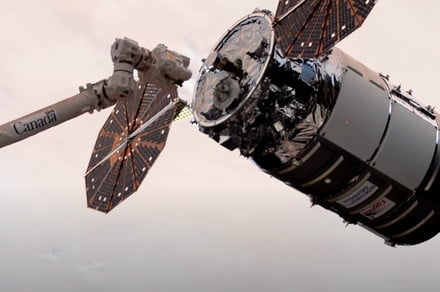The International Space Station (ISS) received its latest delivery of food, tools, and experiments on Monday. It also included a brand new space toilet.
The cargo arrived on the Cygnus spacecraft after launching the previous day aboard Northrop Grumman’s Antares rocket.
NASA astronaut Chris Cassidy and Russian cosmonaut Ivan Vagner used the space station’s robotic arm to assist in the docking procedure 261 miles (420 km) above the South Pacific Ocean, with the procedure finishing at around 5 a.m. PT.
Cygnus, which is also called SS Kalpana Chawla after the first astronaut of Indian origin launched to space but who sadly died in the 2003 Space Shuttle Columbia disaster, will stay docked at the ISS for the next three months.
Cassidy, Vagner, and the third space station inhabitant, Russian cosmonaut Anatoly Ivanishin, wasted no time in unloading Cygnus, with Cassidy tweeting his delight at receiving some fresh edibles from the team back on Earth.
“The best thing about a cargo ship arriving is getting some fresh food,” Cassidy wrote a post that included several photos of what appeared to be apples and oranges.
The best thing about a cargo ship arriving is getting some fresh food! #grapefruit #oranges #carrots #garlic pic.twitter.com/9pbV3Iqumy
— Chris Cassidy (@Astro_SEAL) October 5, 2020
With today’s food becoming tomorrow’s flushable waste, attention will inevitably turn to the brand new toilet that also arrived as part of the cargo. The so-called Universal Waste Management System (UWMS) was designed in response to feedback from astronauts, and so should provide a more comfortable experience when nature calls.
It is smaller and lighter than previous designs, and features improved integration with other components of the station’s water system that will help recycle more urine for astronauts to drink — though only after it’s been properly filtered and processed, of course.
In microgravity conditions, an Earth-like toilet experience could end messily. Space toilets therefore use airflow to pull urine and feces away from the body and into the proper receptacles. With the UWMS, the airflow automatically begins the moment the toilet lid is lifted, “which also helps with odor control,” NASA explains on its website. The new toilet also includes a more ergonomic design that needs less clean-up and maintenance time, and is built with more durable parts that should cut down on maintenance.
The space agency adds: “Less time spent on plumbing means more time for the crew to spend on science and other high-priority exploration-focused tasks.”
It’s not clear when the high-tech space toilet will be ready for its first visitor, but no doubt NASA will let us know when it happens. Though maybe we don’t need photos, Chris.

